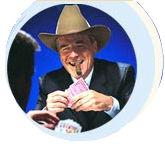People will gamble even if you don’t let them. And if you want to earn a
living off other people’s wagers, the odds are in your favor. The world
never lacks for corrupt public officials and clueless gamblers, both of whom
will help you toward your goal. Those are three of the lessons of Roll the
Bones: The History of Gambling, David G. Schwartz’s remarkably detailed but
unremarkably written history of games of chance. This book covers thousands
of years and a large chunk of the globe in its pursuit of morsels of
information. The locales are exotic, with extended stays in places such as
Monte Carlo. Schwartz starts with the ancients and works his way to Atlantic
City (his birthplace) and beyond. Famous characters – from Augustus Caesar
and Mark Antony to Dostoyevsky and Tolstoy to Frank Sinatra and Elvis
Presley – wander on and off the stage. There’s also a colorful supporting
cast. “Honest” John Kelly, for example, was a small-time gambler/grifter
from Iowa who left a diary that followed his up-and-down adventures, which
never quite led to the wealth or respectability he sought. At his dying
moment, after collapsing at the 1933 Chicago World’s Fair, he said to his
wife: “I almost was a big shot.” Schwartz, a University of Pennsylvania
graduate now at the Center for Gaming Research in Las Vegas, doesn’t neglect
the big picture. Ambivalence toward gambling is a theme that runs through
Roll the Bones. The pattern is a common one: Community (or state or nation)
embraces gambling, then shuns it, taking steps to ban it before letting it
crawl back in. Even when the debate finally seemed to be over, it rarely is.
Schwartz perceives that the current tide is toward a full embrace of
casinos, lotteries, horse racing and other gambling. Governments might not
like them, but they can’t afford to discard the revenue from taxes and
tourism. The path toward acceptance has been smoothed by those who have
turned betting from a seedy vice into a solidly American pastime. “Harrah,”
Schwartz writes of casino operator William Fisk Harrah, “had a simple
philosophy: Provide a pleasant atmosphere for middle-income gamblers, and
let the house advantage take care of the rest.” Steve Wynn is saluted for
trying to be innovative, attracting gamblers by making his casinos
spectacular. The book concludes with the opening of Wynn Las Vegas last
year, and the author treats that event as if it were meant to give his book
an appropriate ending. “A perceptive visitor,” he writes, “walking through
the property, could see the resort as the culmination of 7,000 years of
gambling history.”
That’s a bit over the top, and it stands out because Schwartz is generally
restrained, probably too much so. Roll the Bones certainly didn’t need to
read like The Green Felt Jungle, the brutal and breathless 1963 expose of
Las Vegas, but there’s a sameness to Schwartz’s writing that weighs it down
at times.
That’s particularly true near the end of the book when the author is
bouncing from nation to nation, writing about the recent worldwide boom in
gambling by talking about casino after casino. At that point, switching
gears and going off on some interesting tangents – there’s little or nothing
on Gamblers Anonymous, portrayals of gambling in American culture, or the
universality of NCAA basketball office pools every March – might have made
the book more readable.
